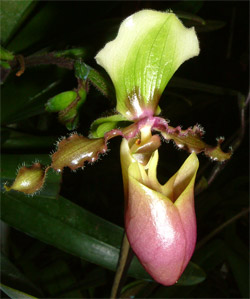Alberto…è proprio lui, ecco il fiore: allego anche una nota liberamente tratta su internet
 Paphiopedilum victoria-mariae (Rolfe) Rolfe 1896 Sottogenere Paphiopedilum Sezione Cochlopetalum Haller ex Pfitz
Paphiopedilum victoria-mariae (Rolfe) Rolfe 1896 Sottogenere Paphiopedilum Sezione Cochlopetalum Haller ex Pfitz
…”This is again a similar species to the other plants in this group which was first described in 1896. It was initially collected by Mr Wilhelm Micholitz in 1891, while travelling for the English nursery of Frederick Sander, England. The collector first heard about the location of a ‘new’ lady slipper species from a Mr Schluechter, who was a bookkeeper at a local coffee plantation, and had to pay him 500 guilders to reveal its actual location. It was originally named Paphiopedilum victoria-regina. One year later Mr Sander renamed it P. victoria-mariae, as on the day Frederick Sander bloomed a plant, the Princess Victoria-Maria (who later became Queen of Great Britain), and the Duke of York, announced their engagement. Because of its long usage this later name has been retained.
September to November flowering (Southern Hemisphere equivalent months), but also throughout the year, it needs a brief rest when growths mature. It appreciates intermediate temperatures. It is native of Mt. Talak Mau, from north Sumatra, Indonesia, where it grows on limestone borders and on exposed cliff faces, but not in direct sunlight. Plants are found in water seepages or in deep pads of moss and humus at an altitude of some 1800 metres on west or west facing slopes. It is also found in moderately dark places as a terrestrial, growing in leafy humus. Living close to the equator, there is little variation in day length, the seasons therefore marked by variations in rainfall. The ‘dry’ season with the south east monsoon starts in December and lasts to April, with frequent rains. In May the north west monsoon starts, with heavy and more frequent rains, which last until September. During most of the year there is heavy cloud cover. Summer temperatures range from 27 to 14.5 degrees celsius, with a 4.5 to 7 degrees celsius drop in winter. It naturally grows in south and central west Sumatra at an altitude of 1500 to 2000 metres above sea level. 105
Jahn who has observed these plants in their natural habitat, confirming plants live the dampness growing in very thick pads of moss.
Fowlie discusses the early history of this species, together with details of a visit to its habitat. He notes that it grows on a tall cliff of andesite lava at an altitude of 1800 to 2050 metres above sea level. The cliff interrupts the flow of moisture laden air currents, which condense on its flanks, and there is a constant trickle of moisture down the cliff face. This trickling moisture permeates the roots of attached pandanus trees, aroids and many other species of plants attached to the cliff, which in turn provides a means of attachment for the mosses, which grow lithophytically up to some 300 mm in thickness. The lower layers of these mosses are rotten but the upper layers are alive, and the roots of the lady slippers are attached through them and along the cliff for some 1300 to 1500 mm from the mother plant, affixed to a tree root or the rock. The habitat is always wet, with mists condensing and moving all the time. The light is extremely dim. He also notes the foliage of the plants is long and thin, not adapted to live in semi-zerophytic or desert conditions as is Paphiopedilum chamberlainianum.
There has been confusion regarding the name of this plant, with P. victoria-regina sometimes applied. However, that name applies m ore correctly to the plant widely known as P. chamberlainianum. 105 Cribb, however, has retained this as a separate species, not withstanding its close affinity to P. victoria-regina (P. chamberlainianum).
Because of its rarity Schaefer notes only 7 primary hybrids have been registered to 1976, with none awarded.”
PS) Un quiz facile facile: il fiore ha un diffetto, lo vedete?

Colpito…speriamo sia solamente un’anomalia incidentale, vedremo il prossimo fiore. By by
Ha, ha, ha, non bluffare a rovescio, io ho visto la pianta ed è ben florida di vegetazioni. Solo che quando la rinvaserai come per magia si divider? da sola in due gruppi ben distinti e non più assimilabili. A parte gli scherzi, questa specie credo sia pubblicata in un sito Italiano per la prima volta. Come detto è stata spesso oggetto di confusione tassonomica a causa anche del nome. Fowlie l’ha denominata victoria-marie, Karasawa victoria-regina sinonimo anche del chambelainianum victoria-reginae, infine Cribb nel 1997 la classificata come victoria-mariae. Spesso scambiata quindi con altre specie o varit? o sinonimi di specie dei Cochlopetalum dai coltivaltori e produttori non è facile trovarla nelle collezioni italiane. Appare a prima vista simile alle specie del gruppo, ma a mio avviso anche facilmente distinguibile, avendone la possibilit? di confronto. Probabilmente non è presente nelle collezioni perchè molti, fidandosi di certe indicazioni presenti in siti, datati e senza foto confrontabili, l’hanno ritenuta quasi identica al victoria-regina, alias chambelainianum, cosa che questo post dimostra non corrispondere per niente al vero. Difetto sullo staminode? Ciao Alberto
Aspetta e spera! Come sai ho solamente una pianta, lenta, lenta, lenta. Ciao
Guido
Esattamente. ! Questo è proprio il victoria-mariae, stupendo!
Come ti ho gi? detto sono gi? prenotato per una divisione.
Mi riservo un ulteriore commento, questa sera su questo Paphiopedilum oggetto di controversa discussione tassonomica (ancora in corso) tra i botanici.